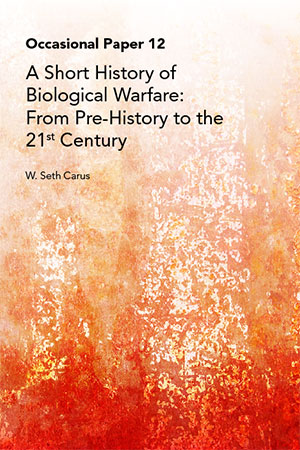Download PDF
Introduction
 This short monograph reviews the history of biological warfare (BW) from prehistory to the present. It covers what we know about the practice of BW and briefly describes the programs that developed BW weapons based on the best available research. To the extent possible, it primarily draws on the work of historians who used primary sources, relying where possible on studies specifically focused on BW. By broadening our knowledge of BW, such studies have enabled us to write about the topic with more accuracy and detail than could have been done even a few years ago.
This short monograph reviews the history of biological warfare (BW) from prehistory to the present. It covers what we know about the practice of BW and briefly describes the programs that developed BW weapons based on the best available research. To the extent possible, it primarily draws on the work of historians who used primary sources, relying where possible on studies specifically focused on BW. By broadening our knowledge of BW, such studies have enabled us to write about the topic with more accuracy and detail than could have been done even a few years ago.
This is an overview, not a definitive history. Much about BW remains unknown, either because it is unknowable (due in some cases to the deliberate destruction of records) or because it is knowable only to some people (such as those who might have access to classified information) or because of the absence of academic research.1
This survey breaks the history of BW into three periods. The first section examines prehistory to 1900—the period before scientific advances proved that microorganisms were the cause of many diseases. Despite many claims to the contrary, resort to BW was exceedingly rare during this era. Readers interested only in BW’s modern history can skip this section.
The second section looks at the years from 1900 through 1945. This period saw the emergence of state BW programs, the employment of biological weapons in both world wars, and the use of biological agents by nonstate actors, including criminals. This period witnessed the most significant resort to BW. It included the first organized state campaign to wage BW—sabotage operations organized by the German government during World War I. It also saw the most extensive use—the Japanese attacks in China. Almost all the known victims of BW were Chinese, mostly civilians, who were killed in these operations. This period also saw the initial efforts to control BW in the 1925 Geneva Protocol, which essentially prohibited the first use of BW agents.
Finally, the third section, covering the period from 1945 to the present, focuses mostly on developments during the Cold War, including descriptions of state BW programs as well as known uses of biological agents by states, terrorists, and criminals. Despite the development of highly sophisticated techniques for dissemination of biological agents by the United States and the Soviet Union during the Cold War (the two countries with the largest and most advanced BW programs ever organized), most of the known programs were small and possessed only crude dissemination capabilities. The known uses were unsophisticated as well, essentially no more advanced than what the Germans did during World War I. This era also saw the negotiation of the 1972 Biological and Toxin Weapons Convention (BWC).
This history focuses on those agents covered by the BWC, which prohibited weapons disseminating biological agents or toxins. Biological agents are replicating biological entities, such as bacteria. Toxins, poisons of biological origin, are similar to chemical warfare agents and also have been banned by the Chemical Weapons Convention. Definitional matters are discussed in more detail in appendix 2.
Biological agents are referred to by their scientific name. Following scientific practice, the name is abbreviated after the first mention. Thus, Bacillus anthracis (commonly, but incorrectly, called anthrax), which causes several diseases (including cutaneous anthrax, inhalational anthrax, and gastrointestinal anthrax), is hereafter called B. anthracis. Those seeking additional information about specific diseases should refer to specialist works that describe them in more detail.2
Readers wishing more detailed information should look at the references cited in the notes. Appendix 1 also provides suggested readings.
Read More